
Gojko Mitic plays the title role in the East German western, Chingachgook, the Great Snake (Chingachgook, die grosse Schlange, 1967), directed by Richard Groschopp.
Westerns not made in the U.S. have always carried a patina of the exotic for fans of the genre. There have been the countless spaghetti westerns from Italy and Spain, Australia has turned out several distinctive efforts (The Man from Snowy River, Mad Dog Morgan, The Proposition) and even Japan has their own brand of western as represented by samurai films like The Seven Samurai and Yojimbo. But have you ever seen a western from East Germany during the 1960s when their film industry was under the control of the Socialist government? If not, Westerns with a Twist, a trilogy from DEFA (aka Deutsche Film-Aktiengesellschaft) starring Gojko Mitic is a great place to begin. This trio of “red westerns” includes The Sons of Great Bear (1966), Chingachgook, the Great Snake (1967) and Apaches (1973).
DEFA was the East Germany film studio that was founded in 1946 and charged with producing movies for the German Democratic Republic, which was under Soviet rule (the studio was officially liquidated after German reunification in 1992). While their West Germany counterparts such as Union-Film GmbH and Erma-Film were producing commercial hits such as Die Halbstarken (1956, aka Teenage Wolfpack) starring Horst Buchholz and Sissi (1955) with Romy Schneider (released in the U.S. in 1962 as Forever My Love), DEFA was struggling to attract a mass audience with its slate of government-approved movies. The films had to conform to acceptable party lines in terms of subject matter and ideology and usually fell under the category of social realism. While very few of these films found their way to America during the Cold War era, there were a few famous exceptions such as Wolfgang Staudte’s critically acclaimed Die Morder sind unter uns (1946, The Murderers Are Among Us) or the more widely seen sci-fi adventure, Der schweigende Stern (1960), which was distributed in the U.S. in a bowdlerized, English language version entitled First Spaceship on Venus.  The turning point came in 1966 when DEFA, drawing inspiration from the enormous popularity of the West Germany Western Der Schatz im Silbersee (1962, aka Treasure of Silver Lake) and its many sequels based on the novels of Karl May, decided to create their own twist on this popular genre and the result was The Sons of Great Bear featuring former stuntman turned actor Gojko Mitic in the title role of Tokei-Ihto, a heroic Sioux warrior bent on ending the exploitation of his people by the white man. DEFA’s first official western (aka Indianerfilm), The Sons of Great Bear proved to be a huge success in East Germany and led to numerous other oaters starring Mitic, all of them constructed with an obvious political agenda.
The turning point came in 1966 when DEFA, drawing inspiration from the enormous popularity of the West Germany Western Der Schatz im Silbersee (1962, aka Treasure of Silver Lake) and its many sequels based on the novels of Karl May, decided to create their own twist on this popular genre and the result was The Sons of Great Bear featuring former stuntman turned actor Gojko Mitic in the title role of Tokei-Ihto, a heroic Sioux warrior bent on ending the exploitation of his people by the white man. DEFA’s first official western (aka Indianerfilm), The Sons of Great Bear proved to be a huge success in East Germany and led to numerous other oaters starring Mitic, all of them constructed with an obvious political agenda.  The popular Karl May series in West German cinema was based on the novels of a German writer who never visited America until 1908, long after he had written most of his frontier sagas. His stories mimicked the plots of American Westerns while featuring the blood-brother tag team of white hunter Shatterhand (Lex Barker) and Apache friend Winnotou (Pierre Brice), though the latter was almost always a supporting character and rarely the sole focus. DEFA’s frontier tales with Gojko Mitic, however, clearly positioned his Native American characters as the sole protagonist and hero while serving up revisionist histories of the wild west that featured a decidedly different point of view.
The popular Karl May series in West German cinema was based on the novels of a German writer who never visited America until 1908, long after he had written most of his frontier sagas. His stories mimicked the plots of American Westerns while featuring the blood-brother tag team of white hunter Shatterhand (Lex Barker) and Apache friend Winnotou (Pierre Brice), though the latter was almost always a supporting character and rarely the sole focus. DEFA’s frontier tales with Gojko Mitic, however, clearly positioned his Native American characters as the sole protagonist and hero while serving up revisionist histories of the wild west that featured a decidedly different point of view.

An early publicity photo for stuntman turned actor Gojko Mitic, who would end up playing countless Native Americans in East German westerns.
Mitic, who was born in Strojkovce, Yugoslavia (which is now Serbia), was an athlete who stumbled into filmmaking while he was a student in Belgrade. He entered the film industry as a stunt man and extra on one of the Lex Barker/Pierre Brice Westerns, Winnetou – 1. Teil (1963, aka Apache Gold), before moving into larger supporting roles in such films as Unter Geiern (1964, aka Amongst Vultures aka Frontier Hellcat). His promotion to leading man with The Sons of Great Bear transformed him into a major star in East Germany. He would go on to specialize in Native American roles in numerous films such as Osceola (1971), Tecumseh (1972) and Der Scout (1983).
Occasionally Mitic would try to escape this screen stereotype by appearing in other genre films like the sci-fi adventure Signale – Ein Weltraumabenteur (1970), the WWII actioner Ich Will Euch Sehen (1978) or the family friendly adventure film Das Herz des Piraten (1988) but his fans preferred him in westerns. Mitic celebrated his 80th birthday on June 13, 2020 and continues to work in film and television. He is currently appearing in the German TV series, Balkanska Medja (2020).

Actor Gojko Mitic, who was born in Yugoslavia (now called Serbia) in 1940, continues to work in film and television today.
The Sons of Great Bear and the other two films included in First Run Features DVD box set, Westerns With a Twist – Chingachgook the Great Snake (Chingachgook, die grosse Schlange) and Apaches (Apachen) – present an idealized, even romanticized view of America’s original inhabitants but considering all the times Native Americans have been demonized in Hollywood Westerns, it’s a refreshing change of pace. Gojko Mitic also has the perfect physique for an action hero as well as the skills of a trained athlete. 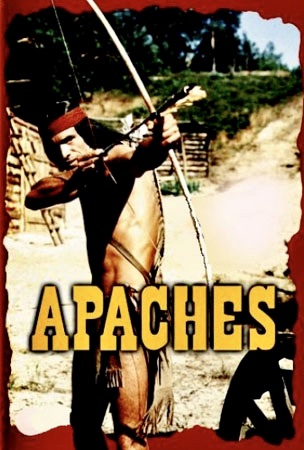 The real question is “Will fans of Hollywood westerns like the DEFA trilogy?” Well, yes and no. It all comes down to personal taste. Certainly compared to classic American westerns, the DEFA films suffer in comparison when it comes to directorial finesse, strong performances, consistent continuity and production budgets (which extend to special effects and stunts). On the other hand, the DEFA trilogy exudes a strange fascination and interest, even when the storylines veer off into ponderous exposition or unintentionally funny set pieces. For example, the various dance numbers in Chingachgook often threaten to turn the movie into a Native American Seven Brides for Seven Brothers as choreographed by Toni Basil (anybody remember her music video “Mickey”?).
The real question is “Will fans of Hollywood westerns like the DEFA trilogy?” Well, yes and no. It all comes down to personal taste. Certainly compared to classic American westerns, the DEFA films suffer in comparison when it comes to directorial finesse, strong performances, consistent continuity and production budgets (which extend to special effects and stunts). On the other hand, the DEFA trilogy exudes a strange fascination and interest, even when the storylines veer off into ponderous exposition or unintentionally funny set pieces. For example, the various dance numbers in Chingachgook often threaten to turn the movie into a Native American Seven Brides for Seven Brothers as choreographed by Toni Basil (anybody remember her music video “Mickey”?).

Tokei-Ihto (Gojko Mitic) offers the peace pipe in The Sons of Great Bear (1966), directed by Josef Mach.
There is always something to engage you here, whether it’s seeing a reenactment of the infamous Johnson Massacre of 1837 from the victims’ viewpoint in Apaches or the unexpected sight of numerous bronzed, half-naked European actors in longhaired wigs speaking German but playing Apaches, Sioux, Huron or other tribal people. There’s also the bizarre intercutting between stunning widescreen vistas (filmed in Romania, Slovakia, Uzbekistan and other unspoiled locales) and claustrophobic interior sets, often cheaply made and shot in the studio. Added to this, the deeply saturated color palette and occasional odd prop or detail (the mystical cave encounter with the man in a giant bear suit in Chingachgook) make it all strangely palatable. 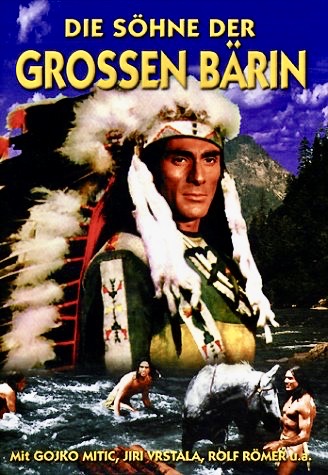 The first film in the DEFA set is The Sons of the Great Bear. Set in the Black Hills of South Dakota, the story takes place during the U.S. government’s relocation of the Sioux for the usual reasons; they want their rich grazing land because it contains gold. Enter Tokei-Ihto (Mitic), whose father has just been murdered by Fred Clarke aka Red Fox (Jiri Vrstala) for refusing to reveal the gold’s location. Instead of exacting bloody revenge, Tokei-Ihto tries to unite the other neighboring Indian tribes in opposing the U.S. military’s attempts to take control of their ancestral lands. His peacemaking attempts are constantly thwarted by Red Fox’s evil schemes and deeds and eventually culminate in the inevitable fight to the death. The simplistic good vs. evil scenario is easy enough for a five-year-old to follow but what is interesting about the movie is the way it stacks the deck against the American settlers and soldiers from the get-go, depicting them as racist, greedy and without honor. Their decadent influence and aggressive assimilation into America is already wreaking havoc on Native American culture via alcohol, broken treaties, unjust trading practices and deception at every turn.
The first film in the DEFA set is The Sons of the Great Bear. Set in the Black Hills of South Dakota, the story takes place during the U.S. government’s relocation of the Sioux for the usual reasons; they want their rich grazing land because it contains gold. Enter Tokei-Ihto (Mitic), whose father has just been murdered by Fred Clarke aka Red Fox (Jiri Vrstala) for refusing to reveal the gold’s location. Instead of exacting bloody revenge, Tokei-Ihto tries to unite the other neighboring Indian tribes in opposing the U.S. military’s attempts to take control of their ancestral lands. His peacemaking attempts are constantly thwarted by Red Fox’s evil schemes and deeds and eventually culminate in the inevitable fight to the death. The simplistic good vs. evil scenario is easy enough for a five-year-old to follow but what is interesting about the movie is the way it stacks the deck against the American settlers and soldiers from the get-go, depicting them as racist, greedy and without honor. Their decadent influence and aggressive assimilation into America is already wreaking havoc on Native American culture via alcohol, broken treaties, unjust trading practices and deception at every turn.
Yet, The Sons of the Great Bear puts a positive spin on this historical moment by having Tokei-Ihto triumph in the end and effectively relocate his people to a pastoral valley far removed from the white man’s domination. We all know how the tale really ends so the upbeat fadeout is wishful thinking. Besides, the film’s real message was already delivered earlier in the film by a captured Indian scout, now working for the U.S. Army, who says to Tokei-Ihto: “Twice we defeated the longknives. But for each casualty 100 appeared. Our weapons are becoming blunt. We cannot escape the white flood. It spreads like a prairie fire. But we melt away….like snow in the spring sun.”

“Die Söhne der großen Bärin” aka The Sons of Great Bear (1966) –
Gojko Mitic (left) defends himself in a knife fight.
In their attempts to present a blistering critique of white capitalist America, the filmmakers go overboard in their use of caricatures and stereotypes and make a good case for the total annihilation of all Caucasians, including East Germans. Still, for all its dramatic deficiencies and naivete, this Communist-endorsed entertainment is endearing in some ways, particularly for its incongruous use of music in a period film, such as a German cabaret number in a frontier bar.
What really gives this first DEFA western entry some substance is Jiri Vrstala’s hissable villain, who runs amok creating mayhem throughout most of The Sons of the Great Bear. In a more detailed analysis of the film by Todd Stadtman for Teleport City, he noted that Vrstala, a Czech actor, “had for years played a popular children’s character called Clown Ferdinand both on East German TV and in the movies. Based on his performance here, it’s easy to imagine that being made to watch Clown Ferdinand was, for East German children, just a more modern equivalent of being taken behind the woodshed.” I’ve never seen Clown Ferdinand but Vrstala does look familiar indeed and checking on his screen credits, I realize I’ve seen him before in Ikarie XB 1 (1963, released in the U.S. as Voyage to the End of the Universe) and …a Paty Jezdec je Strach (1965, The Fifth Horseman is Fear).
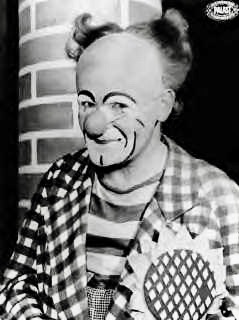
Czech actor Jiri Vrstala was a popular TV star in East German as a children’s show character known as Clown Ferdinand.
As for Gojko Mitic, he was a big star in East German cinema but a skilled actor he is not. To be generous, he is slightly less stolid than Steve Reeves but not as expressive as Clint Eastwood if that gives you any idea of his range. Yet he fits the physical requirements of the proud, stoic character he plays and he can look imposing when the occasion rises or stare you to death with his brooding gaze. What’s missing is a flicker of personality or maybe even a sly sense of humor beneath the buff body. 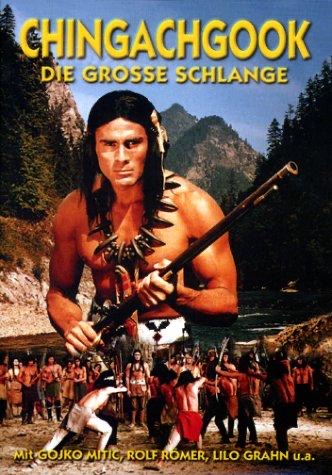 Mitic does loosen up a bit in Chingachgook, the Great Snake in which he performs a solo dance number that looks like it might have been designed for 3-D the way he keeps thrusting his head and hands toward the screen. That choreographed oddity is one of three mind-warping dance highlights in Chingachgook, which is otherwise a fairly straightforward adaptation of James Fenimore Copper’s The Deerslayer.
Mitic does loosen up a bit in Chingachgook, the Great Snake in which he performs a solo dance number that looks like it might have been designed for 3-D the way he keeps thrusting his head and hands toward the screen. That choreographed oddity is one of three mind-warping dance highlights in Chingachgook, which is otherwise a fairly straightforward adaptation of James Fenimore Copper’s The Deerslayer.

Chingachgook (Gojko MItic, left), his bride to be Wahtawa (Andrea Drahota) and Deerslayer (Rolf Romer) spot trouble on the horizon in Chingachgook, the Great Snake (1967).
The real villains here are the deceitful and arrogant British invaders who attempt to turn the Delaware and Huron tribes against each other as a means of undermining their power and seizing their lands. Caught in the middle of this struggle are Tom Hutter (Helmut Schreiber), a trapper, and his daughter Judith (Lilo Grahn), some mercenaries, and Chingachgook (Mitic), a Mohican who has been raised by the Delaware tribe, and his friend Wildtoter (Rolf Romer) aka Deerslayer. Not surprisingly, Deerslayer becomes merely a supporting character in this retelling with the narrative focusing more on Chingachgook’s attempts to rescue his kidnapped, intended bride-to-be Wahtawa (Andrea Drahota) from the Huron, while trying to prevent further genocide for his people.

Gojko MItic remains fearless as he faces possible death from his enemies in Chingachgook, the Great Snake (1967).
Of the three films in the Westerns with a Twist set, Chingachgook is the most eclectic and paints in broad strokes another idealized view of Native American culture juxtaposed against corrupt capitalist settlers and sadistic British officers who are already behaving as if they own everything they see. We never see Indians attacking or plotting violence against their oppressors in this entry or in any of the three DEFA Westerns; they are always the betrayed, the exploited, the victimized. Another curious note is that white hunters and trappers are the ones who are actively engaged in the business of buying and selling scalps as if scalping were a white business enterprise, which calls into question – who introduced scalping into the culture?

The art direction, costumes and on-location settings are always colorful and striking in Chingachgook, the Great Snake (1967).
On a positive note, Chingachgook is quite atmospheric and colorful in terms of the art direction with the bright red uniforms of the invading British soldiers set against the earth tones of the natural surroundings or Hutter’s floating log cabin set in the middle of a pristine lake with a picture-posture view of the mountains. It is also entertainingly bad for its excesses plus I have a certain fondness for it because it was the first DEFA Western I saw (It was screened at the Goethe Institute in Atlanta in 2001).  The absurd dance sequences aside, the movie also has its shares of visual gaffes: A hunter spots a bird overhead, shoots it and then a prop bird lands clumsily at his feet as if someone tossed it into the camera frame; w is mobbed in a pileup of Huron warriors but easily crawls out of the bottom of the huddle unnoticed like a Bugs Bunny gag in a Chuck Jones cartoon. There is also a scene-chewing performance by Horst Preusker, who seems to be channeling Charles Laughton’s Captain Bligh in his role as the hateful British officer Warley. As usual, the music score is often wildly anachronistic. For example, in one scene, the opening of a chest of family heirlooms is accompanied by the blaring sounds of a Dixieland jazz band.
The absurd dance sequences aside, the movie also has its shares of visual gaffes: A hunter spots a bird overhead, shoots it and then a prop bird lands clumsily at his feet as if someone tossed it into the camera frame; w is mobbed in a pileup of Huron warriors but easily crawls out of the bottom of the huddle unnoticed like a Bugs Bunny gag in a Chuck Jones cartoon. There is also a scene-chewing performance by Horst Preusker, who seems to be channeling Charles Laughton’s Captain Bligh in his role as the hateful British officer Warley. As usual, the music score is often wildly anachronistic. For example, in one scene, the opening of a chest of family heirlooms is accompanied by the blaring sounds of a Dixieland jazz band.  Apaches, the final entry in the DEFA set, stands in marked contrast to the two preceding films and is much closer in its look and tone to a Spaghetti Western. Based on historic accounts of an infamous atrocity, Apaches opens as Ulzana (Mitic) prepares to attend a celebration in a nearby town, organized for the local Apache tribes by an American geologist named Johnson (Milan Beli). In cahoots with the Mexican mayor of the town, Johnson is actually planning to massacre his guests and he nearly succeeds, blasting them with cannon fire as his men pick off the other defenseless victims. Ulzana and a few others manage to escape while the dead are then scalped in a grisly sequence that, while non-explicit in its detail, is nonetheless an example of the film’s more realistic approach to violence. The rest of the film is a taut cat-and-mouse chase between Johnson and Ulzana who settles the score in rousing fashion in a finale where the Apaches emerge triumphant.
Apaches, the final entry in the DEFA set, stands in marked contrast to the two preceding films and is much closer in its look and tone to a Spaghetti Western. Based on historic accounts of an infamous atrocity, Apaches opens as Ulzana (Mitic) prepares to attend a celebration in a nearby town, organized for the local Apache tribes by an American geologist named Johnson (Milan Beli). In cahoots with the Mexican mayor of the town, Johnson is actually planning to massacre his guests and he nearly succeeds, blasting them with cannon fire as his men pick off the other defenseless victims. Ulzana and a few others manage to escape while the dead are then scalped in a grisly sequence that, while non-explicit in its detail, is nonetheless an example of the film’s more realistic approach to violence. The rest of the film is a taut cat-and-mouse chase between Johnson and Ulzana who settles the score in rousing fashion in a finale where the Apaches emerge triumphant.

Gojko Mitic plays Apache leader Ulzana in the East German western Apachen (aka Apaches, 1973), directed by Goffried Kolditz.
Made just a year after Robert Aldrich’s Ulzana’s Raid (1972), Apaches bears little relation to that film’s storyline and Mitic’s Ulzana, despite his grievances with the white man, is still a man of incorruptible honor and not a bloodthirsty avenger like the title character of Aldrich’s film. Mitic, who is almost constantly in motion in Apaches, goes beyond his usual male model image to give something like a performance here and it leaves one wanting to see the sequel, Ulzana (1974), which Mitic also co-scripted. The film is also interesting for addressing a subject rarely explored in Westerns – the relationship between Mexicans and Native Americans as they both struggled against a greater oppressor – the U.S. military.  The DEFA Westerns are not for everyone but for those with any interest in seeing how another culture took what was once one of Hollywood’s most popular genres and refashioned it for their own purposes, Westerns with a Twist is an intriguing change of pace. The trilogy was originally released by First Run Features on DVD in October 2006 but now appears to be out of print. My one comment on the presentation is that while these are basically crisp, clean transfers, the aspect ratio is not correct and though letterboxed, crucial information is still missing or cut off from the left and right sides of the frame. This is something that I hope First Run Films will correct in the future if they ever remaster these three films on Blu-ray.
The DEFA Westerns are not for everyone but for those with any interest in seeing how another culture took what was once one of Hollywood’s most popular genres and refashioned it for their own purposes, Westerns with a Twist is an intriguing change of pace. The trilogy was originally released by First Run Features on DVD in October 2006 but now appears to be out of print. My one comment on the presentation is that while these are basically crisp, clean transfers, the aspect ratio is not correct and though letterboxed, crucial information is still missing or cut off from the left and right sides of the frame. This is something that I hope First Run Films will correct in the future if they ever remaster these three films on Blu-ray. 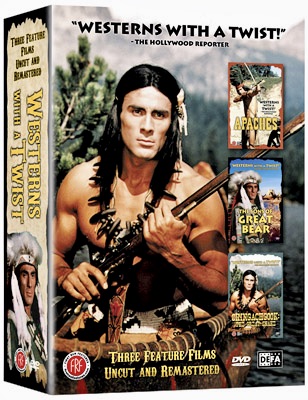 Other websites of interest:
Other websites of interest:
https://jfcoopersociety.org/articles/ALA/2016ala-wegener.html
https://www.nysun.com/arts/when-westerns-made-their-way-east/42479/
https://westernsallitaliana.blogspot.com/2019/11/gojko-mitic-interview.html
http://sauerkrautcowboys.blogspot.com/2011/05/winnetou-et-al-interview-with-gojko.html
https://ecommerce.umass.edu/defa/people/1793
https://www.youtube.com/watch?v=wj-VcFpRqiA
https://www.youtube.com/watch?v=ekb-ncz97aE




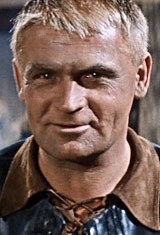
I can report that for this East German child, who loved both the Sons of the Great Bear and Clown Ferdinand, there never was any connection made between the two. The make-up worked too well.
Also, great article.
Also, in current news, our local arts place is doing a project on these movies. There have been questions on the cultural sensitivity – is anyone from an actual native American tribe involved? So far, the replies have been guarded and “we haven’t found anyone”, also if they did, they’d have to think about translating a whole lot of material. But that is the kind of project I would absolutely love. We’d learn something about the reality behind all the movies we’ve watched, and the people from the tribes would learn how much their heritage is somehow alive in a very distant part of the world. The Sons of the Great Bear were based on books by Liselotte Welskopf-Henrich, an anthropologist who did her research and had actual links to the tribes, so I’d really love to see those connections built on somehow.